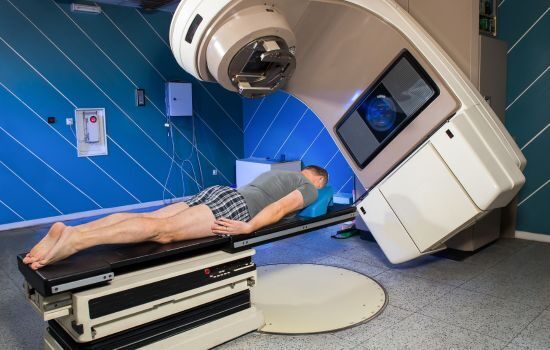Attention GCI Patients — Effective October 6, 2025, the GCI Oak Lawn location will be closed. All patients of GCI Oak Lawn will be seen at our Chicago Ridge location at 10604 Southwest Highway, Suite 109, Chicago Ridge, IL 60415.
September 11, 2023
What is the Difference Between Proton Therapy and External Beam Radiation Therapy for Prostate Cancer Treatment?

The treatment options for prostate cancer range widely from a “wait and see” approach to surgery, hormone therapy, radiation therapy, and even proton therapy. What are these technologies, and how do you know what to use and when?
Most prostate cancers grow slowly and remain in the prostate gland. They typically do not show obvious symptoms or need immediate treatment. However, a small number of prostate cancers are aggressive. Aggressive prostate cancers can spread, grow quickly, and require treatment.
Both proton therapy and external radiation therapy for prostate cancer treatment can provide effective, non-surgical outcomes with fewer long-term side effects. Let’s look at the key differences between these two treatments.
What Determines the Approach to Prostate Cancer Treatment?
After a prostate cancer diagnosis is confirmed, your doctor will determine the extent of your cancer – referred to as its stage. Prostate cancer stages range from I to IV. Stage I cancer is still contained within the prostate and is slow growing – all the way to stage IV, where prostate cancer cells are growing in other areas of the body.
Once the cancer has advanced to the point that treatment is necessary, a personalized plan will be created. The prostate cancer specialist will review the following to determine which set of treatments to recommend.
How fast the cancer is growing (grade)
If it’s spread beyond the prostate (stage)
Your age
Your overall health
Your personal preferences for treatment outcome
For many patients, radiation therapy or proton therapy is a part of their treatment plan, even if they had surgery to remove the prostate.

What Types of Radiation Therapy are Used for Prostate Cancer?
There are a few different ways radiation can be delivered to the prostate to kill cancer cells, including:
External beam radiation therapy (EBRT) uses a linear accelerator to deliver radiation to the specific area where the cancer is located to kill cancer cells. This is a highly precise process with measures taken to protect the anus and the bladder from damage caused by the radiation beams in the same area as the prostate. Imaging is used to precisely pinpoint the location and shape of the radiation beams, which deliver the radiation from several directions and at varying intensities, based on what the patient needs.
Brachytherapy is delivered internally via radiation-containing seeds implanted into or near the tumor. The seeds stay in place, continuing to kill cancer cells as they break down over time. This method requires minor surgery to insert the radioactive seeds.
Radiopharmaceuticals are radiation-containing medicines that are injected into the body to kill cancer cells.
When is Radiation Therapy Used for Prostate Cancer?
Radiation therapy is used for prostate cancer patients in several different ways, such as:
The first treatment for low-grade prostate cancer is contained in the prostate gland. Low-grade cancers have high cure rates, and both radiation and surgery have about the same cure rates.
When combined with hormone therapy, radiation can be the first treatment for prostate cancer that has grown beyond the prostate into the surrounding tissue.
After surgery, radiation is used to kill cancer cells that weren’t removed during surgery.
Recurrent cancer.
With advanced cancer, radiation helps control the cancer that may be growing in other areas of the body. This can reduce symptoms and relieve pain.
How is Proton Therapy Used for Prostate Cancer?
Proton beam therapy is also a non-invasive external radiation that kills cancer cells by disrupting their DNA. It uses proton particles instead of X-rays, which can deliver a higher dose of radiation to different parts of the tumor.
Proton beam therapy targets the cancer in a similar way as radiation therapy. The primary difference is that there is less damage to surrounding tissues with proton therapy. This is because the proton beams stop at the tumor. Radiation X-rays release radiation before and after the X-rays hit the cancer, which is what causes damage to surrounding healthy tissue.
Proton Therapy is Not Always an Option for Prostate Cancer Patients
Although proton therapy has some advantages compared to radiation therapy, it may not always be covered by insurance.
Additionally, other treatments are available if you need a quicker response or if any of the following apply to you:
You have an aggressive cancer that’s causing symptoms, and you need a faster working treatment like radiation
You have a hip joint replacement. This can limit the accuracy of CT imaging, which is essential in planning precise proton beam delivery.
If you have a pacemaker, proton beams can increase the risk of device failure.
How Do Proton and Radiation Therapies Compare for Treatment Effectiveness?
The two therapies have shown no difference in life expectancy. More than half (56%) of proton therapy patients were still alive three years after diagnosis, compared to 58% of radiation therapy patients. Proton therapy has a lower risk of recurrent prostate cancer and secondary cancers that can occur after initial treatment. However, it is not always available, which makes external beam radiation a viable option. Be sure to talk to your oncologist about possible side effects so you can be prepared.
Choosing Between Proton Therapy and Radiation Therapy
If you are considering a prostate cancer treatment plan, be sure you understand all your treatment options based on your cancer‘s specific characteristics, the potential side effects, and your health status before making a decision. Knowing your options will empower you to choose the best treatment for your needs.
Find Expert Prostate Cancer Doctors in the South Chicago Suburbs
The expert oncology team at Affiliated Oncologists can help inform men about the latest treatment options for prostate cancer, including radiation therapy and proton therapy. Our prostate cancer doctors work with you and consider your specific diagnosis and personal preferences before recommending a personalized plan for you.
Find the latest cancer treatments and expert oncologists at all our centers in the South Chicago suburbs, including Chicago Ridge, Hazel Crest, Mokena, Oak Lawn, Orland Park, New Lenox and Palos Heights, Illinois. We also provide second opinions on prostate cancer treatment plans.
Categories: Prostate Cancer